
The Pentatomoidea are a superfamily of insects in the Heteroptera suborder of the Hemiptera order. As Hemiptera, they share a common arrangement of sucking mouthparts. The roughly 7000 species under Pentatomoidea are divided into 21 families. Among these are the stink bugs and shield bugs, jewel bugs, giant shield bugs, and burrower bugs.

Pentatomidae is a family of insects belonging to the order Hemiptera, generally called shield bugs or stink bugs. Pentatomidae is the largest family in the superfamily Pentatomoidea, and contains around 900 genera and over 4700 species. As hemipterans, the pentatomids have piercing sucking mouthparts, and most are phytophagous, including several species which are severe pests on agricultural crops. However, some species, particularly in the subfamily Asopinae, are predatory and may be considered beneficial.

Elasmucha grisea, common name parent bug, is a species of shield bugs or stink bugs belonging to the family Acanthosomatidae. The term parent bugs includes also the other species of the genus Elasmucha and some species of the family Acanthosomatidae.
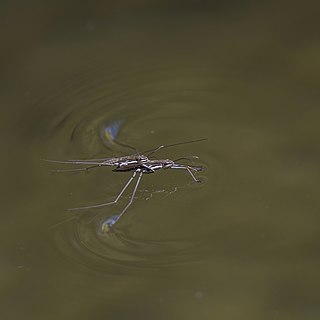
The Gerridae are a family of insects in the order Hemiptera, commonly known as water striders, water skeeters, water scooters, water bugs, pond skaters, water skippers, water gliders, water skimmers or puddle flies. Consistent with the classification of the Gerridae as true bugs, gerrids have mouthparts evolved for piercing and sucking, and distinguish themselves by having the unusual ability to walk on water, making them pleuston (surface-living) animals. They are anatomically built to transfer their weight to be able to run on top of the water's surface. As a result, one could likely find water striders present in any pond, river, or lake. Over 1,700 species of gerrids have been described, 10% of them being marine.

Scutelleridae is a family of true bugs. They are commonly known as jewel bugs or metallic shield bugs due to their often brilliant coloration. They are also known as shield-backed bugs due to the enlargement of the thoracic scutellum into a continuous shield over the abdomen and wings. This latter characteristic distinguishes them from most other families within Heteroptera, and may lead to misidentification as a beetle rather than a bug. These insects feed on plant juices from a variety of different species, including some commercial crops. Closely related to stink bugs, they may also produce an offensive odour when disturbed. There are around 450 species worldwide.
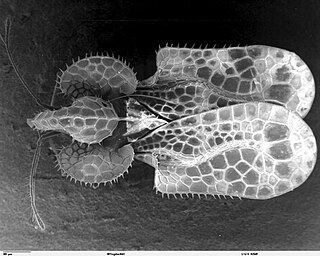
The Cimicomorpha are an infraorder of insects in the order Hemiptera, the true bugs. The rostrum and other morphology of all members apparently is adapted to feeding on animals as their prey or hosts. Members include bed bugs, bat bugs, assassin bugs, and pirate bugs.

Acanthosomatidae is a family of Hemiptera, commonly named "shield bugs" or "stink bugs". Kumar in his 1974 world revision recognized 47 genera; now this number is 55 genera, with about 200 species, and it is one of the least diverse families within Pentatomoidea. The Acanthosomatidae species are found throughout the world, being most abundant in high-latitude temperate regions and in subtropical regions at high altitudes.

Elasmostethus interstinctus, the birch shield bug, is species of shield bug in the Acanthosomatidae family. Shield bugs are often called "stink bugs" because they excrete a foul smelling liquid that is used to deter predators.

Tessaratomidae is a family of true bugs. It contains about 240 species of large bugs divided into 3 subfamilies and 56 genera.

Dinidoridae is a small family of hemipteran "true bugs" comprising about sixteen genera and a hundred species the Hemiptera suborder Heteroptera. As a group the family does not have any common name. Until the late 19th century they were generally regarded as a subfamily of Pentatomidae.

Cermatulus nasalis is a species of predatory shield bug in the family Pentatomidae. It is commonly known as the brown soldier bug or glossy shield bug and is native to Australia and New Zealand.

Dalader is the type genus of coreid bugs in the Daladerini tribe. Species in the genus are distributed in tropical Asia, chiefly Southeast Asia. The genus name is derived from the Sanskrit roots dal meaning leaf and dhru which means bearer. This plant bug genus is distinguished by the which preterminal antennal segment being flattened, pear-shaped, and ridged and the terminal segment being paler. Chalcidoid egg parasites have been recorded from this species. Adults of Dalader acuticosta are fried and eaten in northeastern India.

Musgraveia sulciventris is a large stink bug found in Australia, sometimes known as the bronze orange bug. It is considered a pest, particularly to plants in the citrus group. Bronze orange bugs suck the sap from trees, which causes the flowers and fruit to fall.

Euthyrhynchus floridanus, the Florida predatory stink bug, is a species of carnivorous shield bug in the family Pentatomidae, the only species in the genus Euthyrhynchus. It is native to the hottest parts of the southeastern United States and is considered beneficial because it feeds on many species of pest insects. They also feed on things such as grasshoppers and other small insects. This species also hunts in a pack, with up to twelve.
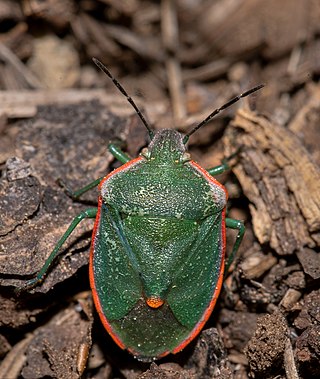
Chlorochroa is a genus of shield (stink) bugs in the family Pentatomidae, found in Europe and North America. There are over 20 described species in Chlorochroa.

Tessaratoma is a genus of bugs in the family Tessaratomidae. There are more than 20 described species in Tessaratoma.
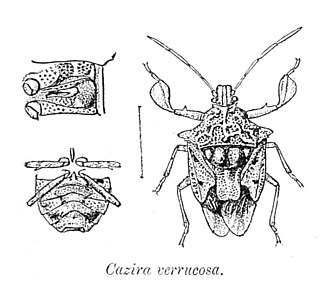
Cazira is a genus of shield bugs found in the Indo-Malayan region.
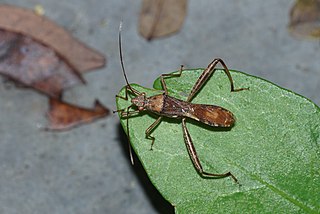
Riptortus is a genus of broad-headed bugs in the family Alydidae. There are more than 20 described species in Riptortus.
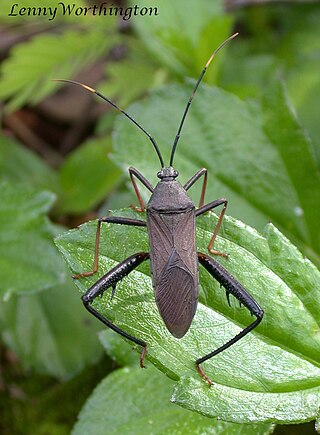
The Cloresmini, sometimes called bamboo coreids, are a tribe of leaf-footed bugs, in the subfamily Coreinae erected by Carl Stål in 1873. Genera are distributed from India, China, Indochina, Malesia through to New Guinea.

Lyramorpha rosea, commonly known as the lychee stink bug, is a species of stink bug in the family Tessaratomidae. It is found in eastern Australia.




















